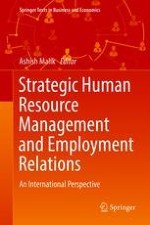2018 | OriginalPaper | Buchkapitel
Strategic Compensation and Benefits Management
verfasst von : Ashish Malik
Erschienen in: Strategic Human Resource Management and Employment Relations
Verlag: Springer Singapore
Aktivieren Sie unsere intelligente Suche, um passende Fachinhalte oder Patente zu finden.
Wählen Sie Textabschnitte aus um mit Künstlicher Intelligenz passenden Patente zu finden. powered by
Markieren Sie Textabschnitte, um KI-gestützt weitere passende Inhalte zu finden. powered by
Abstract
-
Understand the multiple goals of strategic compensation and benefits
-
Describe the dominant approaches to strategic compensation and benefits
-
Analyse the relationship between of strategic compensation and benefits and performance
-
Identify the theoretical bases for determining strategic compensation and benefits
